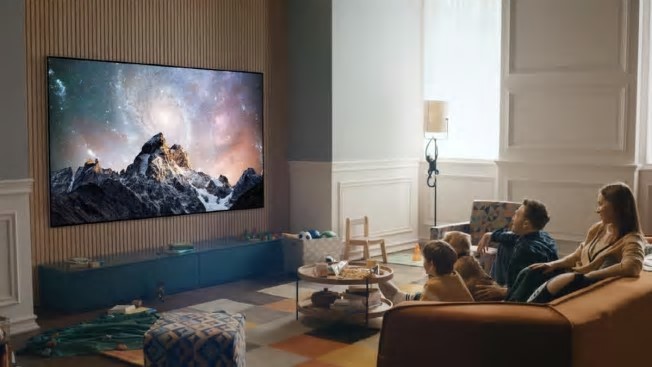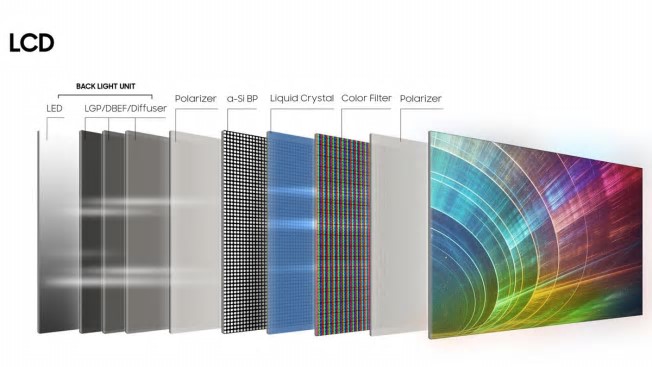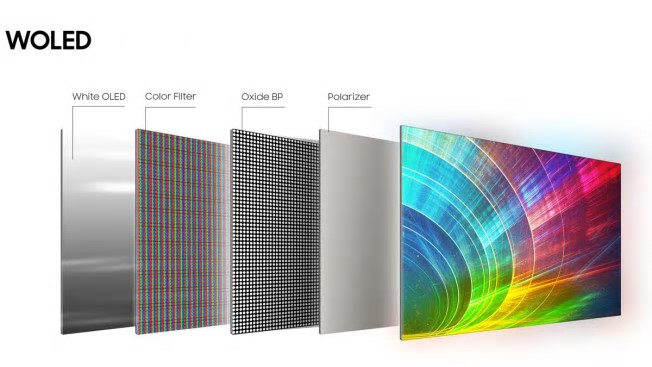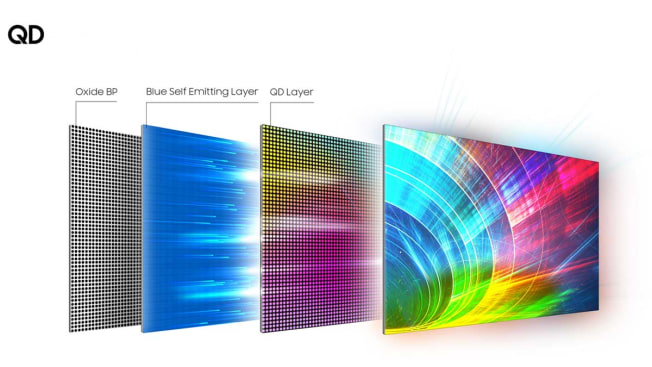TV brands like LG, Samsung, and Sony use a lot of jargon to market their sets. Understanding the terms can help you find a model you'll love at a great price.

Newer display technologies are helping to improve TV performance.
By James K. Willcox
Anyone shopping fora new TVOver the past few years, you have probably seen references to a lot of new screen technologies. It can be confusing, with TV manufacturers promoting an alphabet soup of acronyms, including LED, QLED, OLED, and QD-OLED.
The jargon mainly describes how the TV screens are built. LED and QLED TVs fall into one camp, and OLED and QD-OLED TVs fall into another.
Each type of display has its advantages, but what used to be major differences in performance are now becoming blurred, at least in high-end TVs. That's because manufacturers have gone on an innovation spree, introducing more sets with advanced technology such as quantum dots andMini LED backlightsthat can improve picture quality.
But some of what you hear is just marketing jargon designed to make certain TVs seem more advanced than they truly are. Understanding current tech terms can help you decide whether a slightly older model will suit you just fine—many of those sets are excellent—or whether you should go for a model with the latest features.
What Are LED and QLED TVs?
There are only two basic types of televisions: LCDs and OLEDs. We'll start with LCDs because they account for most TVs on the market.
Here's how an LCD (liquid crystal display) TV works: Unlike OLED TVs, described below, LCD TVs all have a backlight that shines through a filter to produce colors. The backlight is always on, and the liquid crystals act like shutters, opening to allow light through for brighter parts of a scene and closing to block light in dark areas. Some light always escapes, though, which is why black tones on many LCD sets look grayish rather than truly black.
You'll also see many references to LED TVs, but those are really LCD TVs; they just use LEDs in their backlights.
The term LED TV emerged more than a decade ago when companies switched from using fluorescent (CCFL) lamps to LEDs (light-emitting diodes) in LCD TV backlights, mainly because LEDs could be brighter and last longer than fluorescent lamps. They also allowed TVs to be much thinner.
Initially, LED backlights cost more, so some companies seized the opportunity to market the sets to consumers as a new, better type of TV. But they were still LCD sets.
Nowadays, any LCD TV you buy will rely on LEDs. At Consumer Reports, we sometimes refer to LCD/LED TVs to help consumers who have heard both terms, but in our labs, we call them LCD TVs.

LCD TVs consist of several layers, including an LED backlight and color filters. A QLED set replaces the color filter with quantum-dot material.
Source: Samsung Display
That brings us to QLED TVs. Those sets are LCD TVs, with one defining difference: They use quantum dots to produce colors.
QLED TVs from companies such as Amazon, Hisense, LG, Panasonic, Roku, Samsung, Sony, and TCL use a blue LED light source plus a film embedded with tiny quantum dots, which are nano-sized crystals. The quantum-dot film is sandwiched between the other layers of the LCD panel, replacing the color filter in front of the LED backlight.
When those tiny crystals are hit with the blue light from the backlight, they glow, emitting very saturated primary colors, which vary depending on the size and composition of the quantum dot material. The system produces very accurate colors, even at higher brightness levels where colors can start to look a bit washed out.
You should also be aware of two newer enhancements to LCD technology. One is a feature called local dimming, which divides a TV's LED backlights into zones that can be dimmed or illuminated separately. That can help improve contrast and black levels.
It works best with TVs that have full-array backlights, meaning that there are LEDs across the entire back of the set. In contrast, many less expensive LCD TVs on the market are edge-lit sets, with LED backlights along the edges of the display. Those sets may still use local dimming, but it tends to be less effective and sometimes results in an effect called blooming, where you see halos of light around bright images shown against dark backgrounds.
Local dimming can work especially well in TVs thatuse Mini LEDs, the latest backlight advancement. Shrinking the size of the LEDs allows companies to pack more of them into the backlight. Because the LEDs are so small, you can have many dimmable zones - say, 1,000 or more instead of the dozens typically found in even the best LCD sets until recent years. And they can be controlled more precisely to help improve contrast and black levels and reduce halos.
This has created a new set of TV acronyms because some companies have decided to give sets that use quantum dots and Mini LED backlights proprietary names. For example, LG markets its models with those features as QNED TVs (though not all QNED sets have Mini LEDs). Samsung calls them Neo QLED sets. Hisense uses the term ULED TVs, and in 2025, all its ULED TVs will have Mini LED backlights. Both Amazon (Omni series) and Roku Pro- and Plus-series now have Mini LED TVs, and all of TCL’s QM-series sets (QM6, QM7, and QM8) for 2025 have Mini LED backlights.
OLED TVs, described below, have some inherent advantages over LCD sets. However, the best LCD/LED TVs now rival OLEDs in terms of picture quality andHDR performance, which can help a TV present brighter, more vivid images with greater contrast and a wider range of colors, much closer to what we see in real life.
What Are OLED TVs?
At Consumer Reports, we've been evaluating OLED TVs for almost a decade, and those sets have tended to dominate the very top of CR’s ratings.
OLED stands for "organic light-emitting diode." In an OLED TV, each individual pixel emits its own light, so no separate backlight is required. Because each individual pixel can go from bright to fully off, OLED TVs can generate high-contrast images with truly deep black tones.

Traditional OLED TVs, sometimes called WOLED sets, use a white OLED light source along with color filters to create colors.
Source: Samsung Display
Until a few years ago, all OLED TVs from companies including LG, Sony, and Vizio used a type of technology called WOLED. (That's the rare TV acronym that hasn't been used in advertising, by the way.) Those sets have a white OLED light source, plus color filters that produce the red, green, and blue of the color spectrum. You can see the panel structure of that type of TV in the image above.
Because color filters absorb some light, those sets add a white subpixel that bypasses the color filter to add extra brightness. The downside is that at the very high brightness levels required for some HDR content, that extra white subpixel can make colors look a bit washed out.
In the past, OLED TVs lacked the kind of peak brightness we see in the best LCD sets. However, they've been getting brighter, and last year we saw a few OLED TVs that could approach the best LCD peak brightness levels. LG's G4-series sets, such as theLG OLED65G4SUB, and the Panasonic TV-65Z95AP used a new MLA (micro lens array) panel that made them among the brightest OLED TVs we've tested.
In 2025, both manufacturers dropped MLA and are instead using a new "four-stack" OLED technology, where the red and green layers are sandwiched between two blue layers. The companies say that separating the red, green, and blue elements enables TVs to produce brighter images with greater color purity. TVs using that new technology have done very well in our 2025 tests.
What Are QD-OLED TVs?
The desire for extra brightness, especially when displaying very saturated colors, is where QD-OLED TVs come in.
The first two letters stand for quantum dots. Years ago, quantum dots had been used only in LCD-based sets. But both Samsung and Sony introduced QD-OLED TVs in 2022, and then Sharp joined the party. These sets represent a hybrid approach that marries the advantages of traditional OLED TVs—high contrast, deep blacks, and unlimited viewing angles—with the higher peak brightness and more vibrant colors you often get with QLED TVs.

QD-OLED starts with a blue OLED light source and uses quantum-dot material instead of a filter to produce colors.
Source: Samsung Display
Just like QLED TVs, QD-OLED sets start with a blue light source and use quantum-dot material to produce red and green light. But because they are OLEDs, the light source is actually each individual pixel.
Because QD-OLED TVs do not use color filters in front of the light source, they have the potential to achieve higher peak brightness levels without losing any contrast.
In 2025, we've seen continued improvements that allow both WOLED sets and QD-OLED TVs to reach higher brightness levels and help enhance HDR performance. Several TVs this year, including higher-end models from LG, Samsung, and Sony, offer higher peak brightness levels than last year's models, enabling them to deliver a very satisfying HDR experience.
One thing that was a bit confusing last year was that Samsung had both WOLED and QD-OLED models within the S90D-series sets. The 55-, 65-, and 77-inch models used QD-OLED panels, while the 42-, 48-, and 83-inch sets used WOLED. That’s continuing in 2025.
More broadly, the best TVs in any category these days can combine high peak brightness with impressive black levels, plus vibrant, accurate colors and bright screens. That's true for both LCDs and OLEDs. If you're shopping for a television, you have more top-flight choices than ever before.
Consumer Reports is an independent, nonprofit organization that works side by side with consumers to create a fairer, safer, and healthier world. CR does not endorse products or services, and does not accept advertising. Copyright © 2025, Consumer Reports, Inc.
0 comments:
Ikutan Komentar